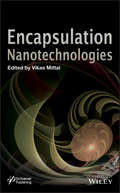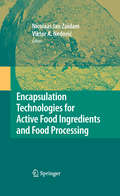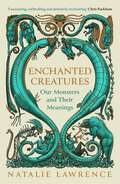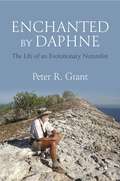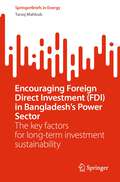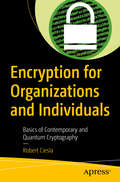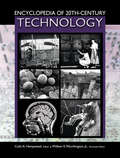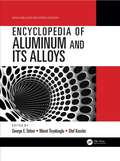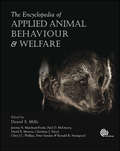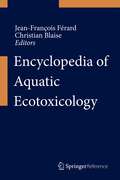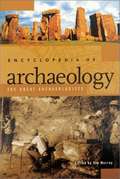- Table View
- List View
Enantioselective Organocatalyzed Reactions I
by Rainer MahrwaldOrganocatalyzed Reactions I and II presents a timely summary of organocatalysed reactions including: a) Enantioselective C-C bond formation processes e.g. Michael-addition, Mannich-reaction, Hydrocyanation (Strecker-reaction), aldol reaction, allylation, cycloadditions, aza-Diels-Alder reactions, benzoin condensation, Stetter reaction, conjugative Umpolung, asymmetric Friedel-Crafts reactions; b) Asymmetric enantioselective reduction processes e.g. Reductive amination of aldehydes or ketones, asymmetric transfer hydrogenation; c) Asymmetric enantioselective oxidation processes; d) Asymmetric epoxidation, Bayer-Villiger oxidation; e) Enantioselective a-functionalization; f) A-alkylation of ketones, a-halogenation and a-oxidation of carbonyl compounds.
Encapsulation Nanotechnologies
by Vikas MittalThis unique and comprehensive book covers all the recent physical, chemical, and mechanical advancements in encapsulation nanotechnologies.Encapsulation is prevalent in the evolutionary processes of nature, where nature protects the materials from the environment by engulfing them in a suitable shell. These natural processes are well known and have been adopted and applied in the pharmaceutical, food, agricultural, and cosmetics industries.In recent years, because of the increased understanding of the material properties and behaviors at nanoscale, research in the encapsulation field has also moved to the generation of nanocapsules, nanocontainers, and other nano devices. One such example is the generation of self-healing nanocontainers holding corrosion inhibitors that can be used in anti-corrosion coatings. The processes used to generate such capsules have also undergone significant developments. Various technologies based on chemical, physical, and physico-chemical synthesis methods have been developed and applied successfully to generate encapsulated materials.Because of the increasing potential and value of the new nanotechnologies and products being used in a large number of commercial processes, the need for compiling one comprehensive volume comprising the recent technological advancements is also correspondingly timely and significant. This volume not only introduces the subject of encapsulation and nanotechnologies to scientists new to the field, but also serves as a reference for experts already working in this area.Encapsulation Nanotechnologies details in part:The copper encapsulation of carbon nanotubesVarious aspects of the application of fluid-bed technology for the coating and encapsulation processesThe use of the electrospinning technique for encapsulationThe concept of microencapsulation by interfacial polymerizationOverviews of encapsulation technologies for organic thin-film transistors (OTFTs), polymer capsule technology, the use of supercritical fluids (such as carbon dioxide), iCVD process for large-scale applications in hybrid gas barriersReadershipEncapsulation Nanotechnologiesis of prime interest to a wide range of materials scientists and engineers, both in industry and academia.
Encapsulation Technologies for Active Food Ingredients and Food Processing
by N. J. Zuidam Viktor NedovicConsumers prefer food products that are tasty, healthy, and convenient. Encapsulation is an important way to meet these demands by delivering food ingredients at the right time and right place. For example, encapsulates may allow flavor retention, mask bad tasting or bad smelling components, stabilize food ingredients, and increase their bioavailability. Encapsulation may also be used to immobilize cells or enzymes in the production of food materials or products, such as fermentation or metabolite production. This book provides a detailed overview of the encapsulation technologies available for use in food products, food processing, and food production. The book aims to inform those who work in academia or R&D about both the delivery of food compounds via encapsulation and food processing using immobilized cells or enzymes. The structure of the book is according to the use of encapsulates for a specific application. Emphasis is placed on strategy, since encapsulation technologies may change. Most chapters include application possibilities of the encapsulation technologies in specific food products or processes. The first part of the book reviews general technologies, food-grade materials, and characterization methods for encapsulates. The second part discusses encapsulates of active ingredients (e.g., aroma, fish oil, minerals, vitamins, peptides, proteins, probiotics) for specific food applications. The last part describes immobilization technologies of cells and enzymes for use within food fermentation processes (e.g., beer, wine, dairy, meat), and food production (e.g., sugar conversion, production of organic acids or amino acids, hydrolysis of triglycerides). Edited by two leading experts in the field, Encapsulation Technologies for Food Active Ingredients and Food Processing will be a valuable reference source for those working in the academia or food industry. The editors work in both industry or academia, and they have brought together in this book contributions from both fields.
Encapsulation in Food Processing and Fermentation (Food Biology Series)
by Steva LevićFood technology has adopted new principles and practices that are rapidly changing the food sector. New foods are now available under more uniform standards and better quality control. Globalised food market offers opportunities for manufacturers to increase production and profit, and at the same time, consumers benefit from the choice of food products like never before. All this is possible only because of the innovations in the food sector. One of such innovations is encapsulation technology, which aims to preserve food quality, enhance the sensorial properties of food and increase the efficiency in food processing. This book discusses the uses of encapsulation technology in food practices and conventional processes and also highlights new directions in food processing. In the introductory chapters’ review of encapsulation technologies, carrier materials and criteria for their selection, analytical methods for characterisation of encapsulated products and some aspects of product design and process optimisation. The most important achievements of encapsulation technology in the food sector are reviewed in the later chapters related to encapsulation of food ingredients, food biocatalysts and examples of usage of encapsulated active ingredients in the dairy and meat industry, beverage production, etc. In addition, the implementation of nanotechnology in the food sector is reviewed, emphasizing the most important materials and technologies for the production of nanoencapsulates. The book is a valuable source of information on encapsulation technology, for academia and industry, especially the food sector, with the aim of enhancing knowledge transfer.
Enchanted Creatures: Our Monsters and Their Meanings
by Natalie LawrenceThe hydra rears its many heads in a flurry of teeth and poisonous fumes. The cyborg lays waste to humanity with a ruthless, expressionless stare.From ancient mythology to modern science fiction, we have had to confront the monsters that lurk in the depths of our collective imagination. They embody our anxieties and our irrational terrors, giving form to what we don't wish to know or understand. For millennia, monsters have helped us to manage the extraordinary complexity of our minds and to deal with the challenges of being human.In Enchanted Creatures, Natalie Lawrence delves into 15,000 years of imaginary beasts and uncovers the other-worldly natural history that has evolved with our deepest fears and fascinations. Join Lawrence on a tour of prehistoric cave monsters, serpentine hybrids, deep-sea leviathans and fire-breathing Kaiju. Discover how this monstrous menagerie has shaped our minds, our societies and how we see our place in nature.
Enchanted by Daphne: The Life of an Evolutionary Naturalist
by Peter R. GrantThe extraordinary life story of the celebrated naturalist who transformed our understanding of evolutionEnchanted by Daphne is legendary ecologist Peter Grant’s personal account of his remarkable life and career. In this revelatory book, Grant takes readers from his childhood in World War II–era Britain to his ongoing research today in the Galápagos archipelago, vividly describing what it's like to do fieldwork in one of the most magnificent yet inhospitable places on Earth. This is also the story of two brilliant and courageous biologists raising a family together while balancing the demands of professional lives that would take them to the far corners of the globe.In 1973, Grant and his wife, Rosemary, embarked on a journey that would fundamentally change how we think about evolution. Over the next four decades, they visited the Galápagos every year to observe Darwin’s famous finches on the remote, uninhabited island of Daphne Major. Documenting how eighteen species have diversified from a single ancestral species, they demonstrated that we could actually see and measure evolution in a natural setting. Grant recounts the blind alleys and breathtaking triumphs of this historic research as he and Rosemary followed in Darwin’s footsteps—and ushered in a new era in ecology.A wonderfully absorbing portrait of a life in science, Enchanted by Daphne is an unforgettable chronicle of the travels and discoveries of one of the world’s most influential naturalists.
Enclosed Experimental Ecosystems and Scale
by W. Michael Kemp John E. Petersen William C. Dennison Victor S. KennedyEnclosed ecosystem experiments have gained in popularity as research tools in ecological science, particularly in the study of coastal aquatic environments. These systems provide scientists with a degree of experimental control that is not achievable through field experiments. Yet to date, techniques for systematically extrapolating results from small-scale experimental ecosystems to larger, deeper, more open, more biologically diverse, and more heterogeneous ecosystems in nature have not been well developed. Likewise, researchers have lacked methods for comparing and extrapolating information among natural ecosystems that differ in scale. Enclosed Experimental Ecosystems and Scale: Tools for Understanding and Managing Coastal Ecosystems provides scientists, managers, and policy makers with an introduction to what has been termed the "problem of scale", and presents information that will allow for improved design and interpretation of enclosed experimental aquatic ecosystems. The book integrates the results of a 10-year research project involving a multi-disciplinary team of scientists and students to explore scale-related questions in a variety of coastal habitats. Anticipating use as a reference, the book has been designed so that individual sections and individual pages can function as stand alone units.
Enclosure Fire Dynamics, Second Edition
by James G. Quintiere Björn KarlssonEnclosure Fire Dynamics, Second Edition explores the science of enclosure fires and how they cause changes in the environment of a building on fire. The authors discuss mechanisms controlling enclosure fires and how to develop analytical relationships useful in designing buildings for fire safety. Derivation of equations from first principles is shown, stating assumptions and showing comparisons to experimental data, giving calculated examples for clarity. The text provides readers with the skills needed to solve a range of engineering equations and problems. Features include: Describes the outbreak of compartment fires and the mechanisms controlling them Derives simple analytical relationships from first principles and shows how to compare the derived equations with experimental data, giving calculated examples for clarity. Provides the calculational procedures and describes computer models needed to design a building for safety Cites the most up-to-date standards and references throughout Includes numerous chapter problems to test student readers’ understanding of fire behavior Enclosure Fire Dynamics, Second Edition will enhance the knowledge of fire protection engineers, researchers, and investigators and help build a strong foundation for engineering students.
Encoding Bioethics: AI in Clinical Decision-Making
by Charles Binkley Tyler LoftusEncoding Bioethics addresses important ethical concerns from the perspective of each of the stakeholders who will develop, deploy, and use artificial intelligence systems to support clinical decisions. Utilizing an applied ethical model of patient-centered care, this book considers the viewpoints of programmers, health system and health insurance leaders, clinicians, and patients when AI is used in clinical decision-making. The authors build on their respective experiences as a surgeon-bioethicist and a surgeon–AI developer to give the reader an accessible account of the relevant ethical considerations raised when AI systems are introduced into the physician-patient relationship.
Encolhi meu melhor amigo! Ooops! Livro 1 (Encolhi meu melhor amigo! #1)
by Katrina Kahler John Zakour Daiana K. NeumannEu encolhi meu melhor amigo! - Ooops! Livro 1: Livros para meninas de 9 a 12 anos escrito por Katrina Kahler e John Zakour. Bella e seu melhor amigo Joe, são duas crianças muito inteligentes que passam cada minuto livre juntos. Um dia, eles elaboram um plano, um plano que os tornará super ricos e super famosos. É um plano tão bom que eles poderão deixar a escola e até ter seu próprio programa de TV! O que poderia ser melhor que isso? No entanto, o plano não acontece Bella e Joe esperavam, e eles se vêem diante de um enorme problema; um que eles são incapazes de resolver por conta própria. Então, quando a paixão secreta de Bella na escola se envolve, as coisas começam a ficar ainda mais interessantes. Este é um livro muito engraçado do começo ao fim, e irá mantê-la rindo, bem como tentar adivinhar o que acontecerá a seguir. Um ótimo livro para meninas e também um ótimo livro para meninos. Na verdade, é uma história fabulosa para quem gosta de livros engraçados. Perfeito para crianças de 9 a 12 anos, esta história vai mantê-lo entretido desde o início! Gênero: FICÇÃO JUVENIL / Quadrinhos e Romances Gráficos / Geral Gênero Secundário: FICÇÃO JUVENIL/ Ciência e tecnologia
Encontros Imediatos com a Humanidade: Uma Nova Visão Sobre a Evolução Humana
by Sang-Hee Lee Shin-Young YoonUma nova visão sobre a Evolução Humana. De onde viemos, como vivemos ou porque temos esta aparência são algumas das questões fundamentais que nos ocorrem nalgum ponto das nossas vidas. Uma nova visão sobre a Evolução Humana De onde viemos, como vivemos ou porque temos esta aparência são algumas das questões fundamentais que nos ocorrem nalgum ponto das nossas vidas. A evolução humana é um campo em constante mudança, não havendo, por isso, respostas certas nem perguntas erradas. Neste livro fascinante, Sang-Hee Lee explora e questiona alguns dos pressupostos evolutivos a partir de novos e inesperados ângulos. A agricultura foi um passo em falso na evolução humana? Porque é o parto tão difícil para as mulheres? Porque é que os humanos adultos bebem leite? O que temos em comum com os neandertais? As histórias presentes neste livro oferecem uma nova perspetiva sobre os primeiros hominíneos, desafiando as perceções sobre a progressão tradicional da evolução. Combinando uma visão antropológica com investigação inovadora, as surpreendentes conclusões da autora lançam uma nova luz sobre os primórdiosda humanidade. À medida que avançamos na evolução, Lee ajuda-nos a determinar para onde caminhamos e aborda uma das questões científicas mais urgentes: será que a humanidade continua a evoluir? Os elogios da crítica: «Um dos melhores livros de ciências do ano.» -Instituto Smithsonian «De forma sucinta e cativante, Lee revisita as principais questões sobre a história da evolução da nossa espécie.» - Nature «Uma nova visão sobre a nossa singularidade.» - New Scientist
Encounters With the Paranormal: Best of Skeptical Inquirer
Do polygraph tests really detect lies? Can memories be implanted? Is subliminal perception a reality? What is the relationship between science and belief?Experts in the fields of physical/biological science, psychology, philosophy, social science, and forensic science bring their perspectives to controversies that affect the way we think and how we perceive reality and the natural world. From science's influence on beauty to antiscience in our universities and from UFO mythologies to near-death experiences, this volume spans the gamut of pseudoscience today.Contributors include James Alcock, Susan Blackmore, Alan Cromer, Mandy Fowler, Christopher C. French, Martin Gardner, Thomas Gilovich, Theodore Goertzel, Paul R. Gross, Peter Huston, Ray Hyman, Noretta Koertge, Paul Kurtz, Dan Larhammar, Leon M. Lederman, James Lett, Norman Levitt, Scott O. Lilienfeld, Elizabeth Loftus, Lee Loevinger, Katy McCarthy, Joe Nickell, Bernard Oritz de Montellano, Debbie Peers, Anthony Pratkanis, Carl Sagan, Kenneth Savitsky, Glenn Seaborg, Elie Shneour, Matthew Smith, Victor Stenger, Jeffrey F. Victor, Jeff Wiseman, and Richard Wiseman.
Encouraging Foreign Direct Investment: The key factors for long-term investment sustainability (SpringerBriefs in Energy)
by Tareq MahbubThis book identifies and investigates the determinants that influence investment decision-making for conducting foreign direct investment (FDI) in Bangladesh’s power sector. This book is organized around six core themes. These are: Bangladesh’s vision to become a middle-income country by 2021 and have universal power for all; an overview of the benefits and costs of FDI from a host nation’s perspective; an outlook of Bangladesh’s power sector starting from the years 1994-2008 through 2011-2015 to 2016-2020 and beyond; the key factors that encourage foreign investors to conduct FDI in the Bangladeshi power sector subsumed under four broad categories of investment prospects namely, regulatory, economic and financial, political and social; the key barriers that deter FDI in the Bangladeshi power sector; and policy implications for long-term investment sustainability in the power sector.The main arguments posited in this book are: regulatory aspects are the most important for firms when conducting FDI in the power sector; land acquisition is a perineal problem that continues to hamper the development of large-scale power projects; there is a need for a transparent and competitive selection process to improve transparency and accountability in private power procurement; and more exploration of onshore and offshore gas fields with the extension of gas transmission networks be enhanced that ensure a regional balance of primary energy supply (gas) for setting up additional gas-based power plants in the country.
Encryption and Decryption Algorithms for Plain Text and Images using Fractional Calculus (Synthesis Lectures on Engineering, Science, and Technology)
by Rafael Martínez-Guerra Juan Javier Montesinos-García Juan Pablo Flores-FloresThis book offers an alternative for encrypting and decrypting messages using objects called integer and fractional-order estimators or observers, by means of security codes. The authors first establish the class of observers capable of carrying out this work. Then, the type of observers to treat either the integer or fractional order type and their main characteristics is mentioned. The book also presents an essential property of some systems such as Liouville, which is vital for the encryption and decryption of messages in integer and fractional order nonlinear systems by using the synchronization property of chaotic systems. Finally, it addresses some logistic maps such as Mandelbrot sets including Julia and fractal sets, taking advantage of their characteristics to encrypt or recover messages.
Encryption for Organizations and Individuals: Basics of Contemporary and Quantum Cryptography
by Robert CieslaCryptography and encryption aren't just for geeks and spies—they’re also part of our daily lives. This book enlightens you with the basics of digital cryptography and covers the must-do practices organizations need to implement when it comes to fending off data theft and eavesdroppers. You will uncover the concepts of digital encryption and examine key digital encryption algorithms and their various applications. Gauging cryptography from an enterprise perspective, you will get an in-depth look at common attacks that can occur in your systems and lean how to counter themMoving on to quantum computing, you will discover how it differs from the current computing paradigm and understand its potential for the future. After clearing the basics, you will take a close look at how quantum computers work in practice. Shifting focus to quantum cryptography, you will learn more about quantum key distribution (QKD) and how it differs from present-day encryption methodologies. You will also consider the current implementations of QKD, including distribution systems by SwissQuantum and QKD-distribution networks provided by the DARPA Quantum Network. Ultimately, you will learn the means of defending against cryptographic attacks in the up-and-coming quantum age, such as utilizing zero-knowledge proof (ZKP) systems.Deepen your knowledge of cryptographic concepts and be introduced to the new paradigm of quantum cryptography with this book. What You Will LearnAppreciate how digital encryption algorithms workSecure your infrastructure from cryptographic attacksUnderstand the basics of quantum information scienceDiscover how cryptography relates to quantum computingImplement Quantum Key Distribution (QKD) Who This Book Is ForThis book is aimed at readers who have an interest in both well-established and up-and-coming types of cryptography, as well as members of organizations to whom privacy is a top priority.
Encyclopaedia of Classical Indian Sciences
by Helaine Selin Roddam NarasimhaThis book is an attempt to provide an authentic account of natural science, technology and medicine as practiced by Indians and other South Asians. It also includes biographical articles on ancient Indian scientists.
Encyclopedia of 20th-Century Technology
by Colin A. HempsteadComprised of 395 essays arranged alphabetically, most on individual objects, artifacts, techniques, and products, this is an up-to-date reference work for all those involved in teaching or researching the history of twentieth-century technology, as well as the serious general reader. The core of each of the main entries is a technical description, within a historical narrative, of about 1,000 words plus illustrations and further reading. There are also about 30 longer survey entries that that address broad questions of technological systems, such as the context in which the various technologies were developed, discussions of any controversies and schools of thought, comparisons between different political and economics systems, and the various ways in which different nations have attempted to make and apply science and technology policies.
Encyclopedia of Agricultural, Food, and Biological Engineering
by Dennis R. Heldman Carmen I. MoraruThe Definitive Reference for Food Scientists & EngineersThe Second Edition of the Encyclopedia of Agricultural, Food, and Biological Engineering focuses on the processes used to produce raw agricultural materials and convert the raw materials into consumer products for distribution. It provides an improved understanding of the processes used in
Encyclopedia of Aluminum and Its Alloys, Two-Volume Set (Metals and Alloys Encyclopedia Collection)
by George E. Totten Murat Tiryakioglu Olaf KesslerThis encyclopedia, written by authoritative experts under the guidance of an international panel of key researchers from academia, national laboratories, and industry, is a comprehensive reference covering all major aspects of metallurgical science and engineering of aluminum and its alloys. Topics covered include extractive metallurgy, powder metallurgy (including processing), physical metallurgy, production engineering, corrosion engineering, thermal processing (processes such as metalworking and welding, heat treatment, rolling, casting, hot and cold forming), surface engineering and structure such as crystallography and metallography.
Encyclopedia of Applied Animal Behaviour and Welfare
by David Morton Peter Sandøe Jeremy Marchant-Forde Clive Phillips Christine Nicol Paul Mcgreevy Daniel Mills Ronald SwaisgoodWelfare research has established a range of scientific indicators of stress, welfare and suffering in animals that can be applied to all aspects of improving their welfare through good housing and management, and the topic continues to grow in importance among both professionals and the public. The practical focus of this authoritative, comprehensive encyclopedia aims to promote the understanding and improvement of animals' behaviour without compromising welfare. Under the editorial direction of Professor Daniel Mills, the UK's first specialist in veterinary behavioural medicine, over 180 international experts have contributed a wealth of fully cross-referenced entries from concise definitions to detailed short essays on biological, practical, clinical and ethical aspects of behaviour and welfare in domestic, exotic, companion and zoo animals.
Encyclopedia of Aquarium and Pond Fish (DK Pet Encyclopedias)
by David AldertonThe most complete owner's manual for keeping all types of freshwater and saltwater fish in indoor tropical and coldwater aquariums and outdoor ponds.Choose the right fish for any water temperature--tropical or coldwater--and for all types of environments, including indoor aquariums or outdoor ponds. Know the difference between keeping saltwater fish and freshwater fish, including differences in aquarium setups, and feeding and caring for your pet fish. Learn to tell whether your fish are healthy and find out everything you need to breed them successfully. The Encyclopedia of Aquarium and Pond Fish contains a huge photographic color reference directory of more than 800 of the most popular fish, not only showing you what they look like, but also giving you key information you need, such as how big they will grow, whether they integrate with different fish, what food they eat, and what water type and temperature they prefer.
Encyclopedia of Aquatic Ecotoxicology
by Christian Blaise Jean-Francois FérardWith its 104 chapters, this Encyclopedia of aquatic ecotoxicology reveals the diversity of issues, problems and challenges that have faced, and are facing today, receiving environments. It also indicates ways by which tools, strategies and future investigations can contribute to correct, minimize, solve and prevent water quality degradation. Structured homogeneously, the chapters convey salient information on historical background, features, characteristics, uses and/or applications of treated topics, often complemented by illustrations and case studies, as well as by conclusions and prospects. This work is most suitable for teaching purposes. Academics, for example, could literally deliver comprehensive lectures to students simply based on chapter outlines and contents. Meet the Authors of the Encyclopedia! Check out 'Meet the Authors' under ADDITIONAL INFORMATION (Right menu).
Encyclopedia of Archaeology, Volume 1: The Great Archaeologists
by Tim MurrayThis two-volume set contains 58 biographies that constitute a history of archaeology from its beginnings in Renaissance antiquarianism, to the present day. Arranged chronologically, each entry contains a brief summary of the individual's importance and a discussion of the life and contributions of the person (with a focus on his or her role in the development of archaeology as a discipline), and a bibliography.
Encyclopedia of Astronomy & Astrophysics
by Paul MurdinIn a unique collaboration, Nature Publishing Group and Institute of Physics Publishing have published the most extensive and comprehensive reference work in astronomy and astrophysics. This unique resource covers the entire field of astronomy and astrophysics and this online version includes the full text of over 2,750 articles, plus sophisticated search and retrieval functionality and links to the primary literature. The Encyclopaedia's authority is assured by editorial and advisory boards drawn from the world's foremost astronomers and astrophysicists. This first class resource is an essential source of information for undergraduates, graduate students, researchers and seasoned professionals, as well as for committed amateurs, librarians and lay people wishing to consult the definitive astronomy and astrophysics reference work.

